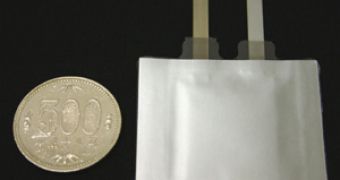If organic flexible displays are somewhat of a normal occurrence by now the same thing can't be said about flexible batteries, but NEC is set to change all that, its super-thin Organic Radical Battery (ORB) showing us that batteries can be flexible too.
Coming in about as large as a coin and only 0.7mm thick, these new ORB prototypes produce about 1.4 times more output power than existing units, NEC achieving that by using a highly conductive nano-composite cathode developed by converting solid organic radical material into a gel and uniformly compounding it with carbon materials.
The result is a battery with 7kW power output (per battery with 5mAh capacity), this coming to 40% more than the previous generation, according to NEC.
Further improvements are achieved thanks to anodes that feature the same carbon material as lithium-ion batteries, enabling ORB prototypes to hold their capacity even after repeated charge-discharge cycles.
Furthermore, using this type of anodes also decreases the manufacturing costs, NEC stating these are approximately 1/10 the price of existing units, making them a lot more practical for mass production.
These technologies will be exhibited at NEC's "C&C User Forum & iEXPO 2010" held between 11 and 12 November at the Tokyo International Forum, and although further plans regarding this technology were not revealed, if NEC has it its way these could come as a great addition to portable devices.
End of it all, I can only hope that NEC will manage to further develop this technology and bring it into mass production as modern day gadgets clearly suffer when it comes down to battery technology and NEC's ORB could prove to be a solution to these problems.
And if that still isn't enough to arouse your interest, then just think at all the devices that could be developed thanks to ORB batteries, a flexible color ePaper tablet sounding pretty cool in my book.

 14 DAY TRIAL //
14 DAY TRIAL //